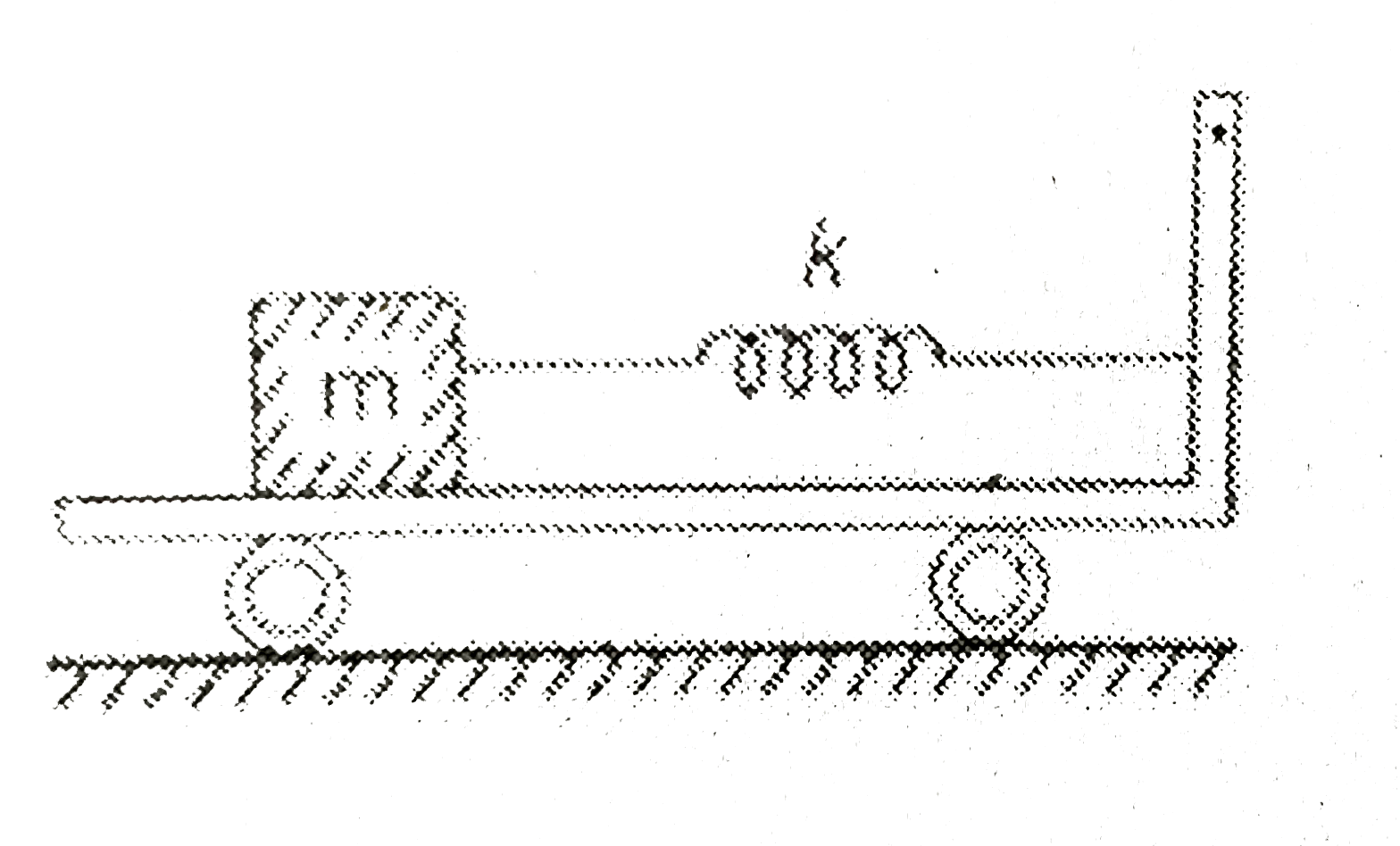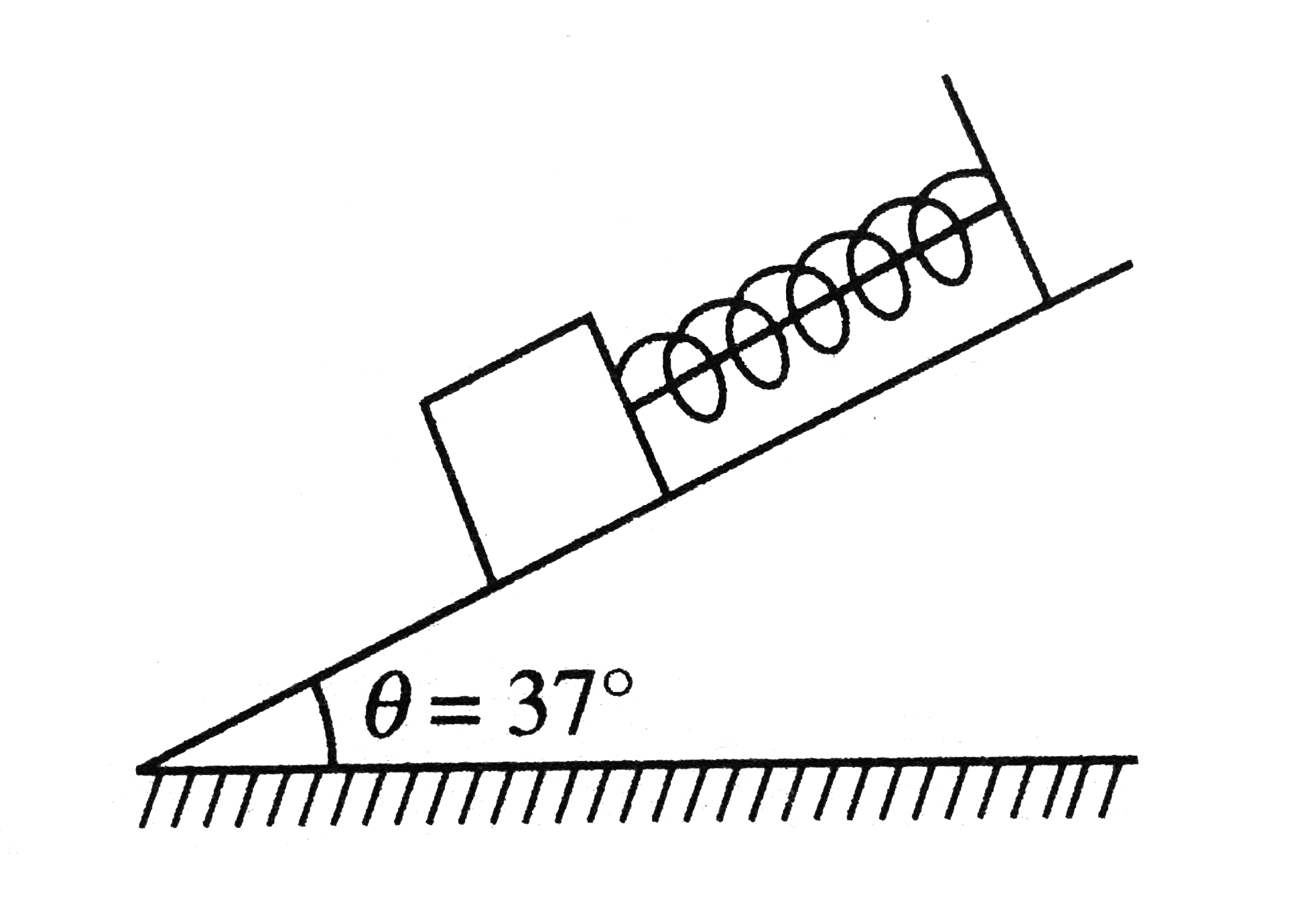A mass of 0.2 hg is attached to the lower end of a massles spring of force constant 200Nm the opper end of which is fixed to a rigid support. Study the following statements.
In equilibrium , the spring will be stretched by 1 cm
If the mass is raised till the spring becomes unstretched and then released , it will go down by 2 cm before moving upwards
The frequency of oscillation will be nearly 5 Hz
All of the above
The correct Answer is:D
To solve the problem step by step, we need to analyze the given information about the spring-mass system and evaluate the statements provided.
Step 1: Understand the system
We have a mass of 0.2 kg attached to a spring with a spring constant k=200N/m. The system is in equilibrium when the gravitational force acting on the mass is balanced by the spring force.
Step 2: Calculate the gravitational force
The gravitational force Fg acting on the mass can be calculated using the formula:
Fg=m⋅g
Where:
- m=0.2kg
- g=10m/s2 (approximate value of acceleration due to gravity)
Calculating:
Fg=0.2kg⋅10m/s2=2N
Step 3: Set up the equilibrium condition
At equilibrium, the spring force Fs is equal to the gravitational force:
Fs=k⋅x
Where x is the stretch in the spring. Setting Fs=Fg:
k⋅x=m⋅g
Step 4: Solve for the stretch x
Rearranging the equation to find x:
x=m⋅gk
Substituting the known values:
x=2N200N/m=0.01m=1cm
Conclusion for Statement 1
The first statement is correct: In equilibrium, the spring will be stretched by 1 cm.
Step 5: Analyze Statement 2
If the mass is raised until the spring is unstretched and then released, it will fall due to gravity. The maximum stretch will be the same as the equilibrium stretch, which is 1 cm downward.
When released, it will fall 1 cm to reach the equilibrium position and then continue to move an additional 1 cm downward (to the maximum displacement). Thus, it will move down by a total of 2 cm before moving upwards.
Conclusion for Statement 2
The second statement is also correct: The mass will go down by 2 cm before moving upwards.
Step 6: Analyze Statement 3
The frequency of oscillation f for a mass-spring system is given by:
f=12π√km
Substituting the values:
f=12π√200N/m0.2kg
Calculating:
f=12π√1000=102π≈106.28≈1.59Hz
This is approximately 5 Hz.
Conclusion for Statement 3
The third statement is incorrect: The frequency of oscillations is not nearly 5 Hz.
Final Conclusion
- Statement 1: Correct
- Statement 2: Correct
- Statement 3: Incorrect
We have a mass of 0.2 kg attached to a spring with a spring constant k=200N/m. The system is in equilibrium when the gravitational force acting on the mass is balanced by the spring force.
The gravitational force Fg acting on the mass can be calculated using the formula:
Fg=m⋅g
Where:
- m=0.2kg
- g=10m/s2 (approximate value of acceleration due to gravity)
Fg=0.2kg⋅10m/s2=2N
At equilibrium, the spring force Fs is equal to the gravitational force:
Fs=k⋅x
Where x is the stretch in the spring. Setting Fs=Fg:
k⋅x=m⋅g
Rearranging the equation to find x:
x=m⋅gk
Substituting the known values:
x=2N200N/m=0.01m=1cm
The first statement is correct: In equilibrium, the spring will be stretched by 1 cm.
If the mass is raised until the spring is unstretched and then released, it will fall due to gravity. The maximum stretch will be the same as the equilibrium stretch, which is 1 cm downward.
The second statement is also correct: The mass will go down by 2 cm before moving upwards.
The frequency of oscillation f for a mass-spring system is given by:
f=12π√km
Substituting the values:
f=12π√200N/m0.2kg
Calculating:
f=12π√1000=102π≈106.28≈1.59Hz
This is approximately 5 Hz.
The third statement is incorrect: The frequency of oscillations is not nearly 5 Hz.
- Statement 1: Correct
- Statement 2: Correct
- Statement 3: Incorrect
Similar Questions
A mass of 0.2 kg is attached to the lower end of a massless spring of force constant 200Nm the other end of which is fixed to a rigid support. Study the following statements.
View SolutionA block of mass 1 kg is attached to one end of a spring of force constant k = 20 N/m. The other end of the spring is attached to a fixed rigid support. This spring block system is made to oscillate on a rough horizontal surface (μ=0.04). The initial displacement of the block from the equilibrium position is a = 30 cm. How many times the block passes from the mean position before coming to rest ? (g=10m/s2)
View SolutionA ball of mass m is attached to the lower end of a light vertical spring of force constant K. The upper end of the spring is fixed. The ball is released from rest with the spring at its normal ( unstretched ) length, and comed to rest again after descending through a distance x.
View SolutionA block of mass m is attached to one end of a mass less spring of spring constant k. the other end of spring is fixed to a wall the block can move on a horizontal rough surface. The coefficient of friction between the block and the surface is μ then the compession of the spring for which maximum extension of the spring becomes half of maximum compression is .
View SolutionA block of mass m is attached to a massless spring of force constant k, the other end of which is fixed from the wall of a truck as shown in figure. The block is placed over a smooth surface and initially the spring is unstretched. Suddenly the truck starts moving towards right with a constant accleration a0. As seen from the truck
 View Solution
View SolutionA solid sphere of radius R and density ρ is attached to one end of a mass-less spring of force constant k. The other end of the spring is connected to another solid sphere of radius R and density 3ρ. The complete arrangement is placed in a liquid of density 2ρ and is allowed to reach equilibrium. The correct statements(s) is (are)
View SolutionA solid sphere of radius R and density ρ is attached to one end of a mass-less spring of force constant k. The other end of the spring is connected to another solid sphere of radius R and density 3ρ. The complete arrangement is placed in a liquid of density 2ρ and is allowed to reach equilibrium. The correct statements(s) is (are)
View SolutionA small block of mass m=1kg is attached with one end of the spring of force constant K=110Nm−1. Other end of the spring is fixed to a rough plane having coefficient of friction μ=0.2. The spring is kept in its natural length by an inextensible thread ties between its ends as shown in figure. If the thread is burnt, calculate the elongation of the spring when the block attains static equilibrium position.
 View Solution
View SolutionA body of mass M is attached to the lower end of a metal wire, whose upper end is fixed . The elongation of the wire is l.
View SolutionA particle of mass m is attached to one end of a mass-less spring of force constant k, lying on a frictionless horizontal plane. The other end of the spring is fixed. The particle starts moving horizontally from its equilibrium position at time t=0 with an initial velocity u0. when the speed of the particle is 0.5u0, it collides elastically with a rigid wall. After this collision
View Solution

